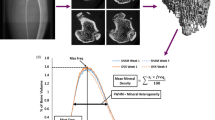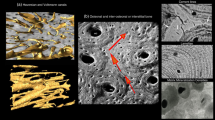Summary
It is proposed that there are two structurally different forms of bone loss with different rates, cellular mechanisms, and biomechanical effects. Rapid bone loss is the result of excessive depth of osteoclastic resorption cavities. This leads in trabecular bone to perforation of structural elements, increased size of marrow cavities, and discontinuity of the bone structure, and in cortical bone to subendosteal cavitation and conversion of the inner third of the cortex to a trabecularlike structure, which then undergoes the same changes as the trabecular bone originally present. These structural characteristics reduce the strength of the bones to a greater extent than the reduction in the amount of bone by itself would suggest. Slow bone loss results from incomplete refilling by osteoblasts of resorption cavities of normal or reduced size. This leads to simple thinning of residual structural elements in both trabecular and cortical bone, and reduces the strength of the bones in proportion to the reduction in the amount of bone. This concept, although derived mainly from an examination of postmenopausal bone loss, may be applicable to other osteopenic states. At the same time as bone loss is occurring on the endosteal surface, rapidly or slowly, bone is being added to the periosteal surface, but much more slowly than during growth. The cellular mechanism is the converse of that causing slow bone loss, consisting of slight overfilling of shallow resorption cavities. Slow periosteal gain serves to partly offset the structural weakness resulting from endosteal loss, but is not directly compensatory. Although less well established and of uncertain frequency and magnitude, it is likely that localized bone gain also occurs on some trabecular surfaces, especially the vertical trabecular plates in the spine that are subjected to compression. In contrast to periosteal gain, this may be a compensatory response to loss of horizontal trabeculae, but the cellular mechanism is unknown.
Similar content being viewed by others
References
Parfitt AM, Duncan H (1982) Metabolic bone disease affecting the spine. In: Rothman R, Simeone F (eds) The spine. 2nd ed, WB Saunders, Philadelphia
Parfitt AM, Mathews CHE, Villanueva AR, Kleerekoper M, Frame B, Rao DS (1983) Relationships between surface, volume and thickness of iliac trabecular bone in aging and in osteoporosis: implications for the microanatomic and cellular mechanisms of bone loss. J Clin Invest
Riggs BL, Wahner HW, Dunn WL, Mazess RB, Offord KP, Melton LJ III (1981) Differential changes in bone mineral density of the appendicular and axial skeleton with aging. J Clin Invest 67:328–335
Nordin BEC, Peacock M, Crilly RG, Francis RM, Speed R, Barkworth S (1981) Summation of risk facors in osteoporosis. In: DeLuca HF, Frost HM, Jee WSS, Johnston CC Jr, Parfitt AM (eds) Osteoporosis. Recent advances in pathogenesis and treatment. University Park Press, Baltimore, p 359
Riggs BL, Melton LJ III, Wahner HW (1983) Heterogeneity of involutional osteoporosis: evidence for two distinct osteoporosis syndromes. In: Frame B, Potts J Jr (eds) Clinical disorders of bone and mineral metabolism. Elsevier, Amsterdam
Whitehouse WJ (1977) Cancellous bone in the anterior part of the iliac crest. Calcif Tissue Res 23:67–76
Parfitt AM (1979) The quantum concept of bone remodeling and turnover. Implications for the pathogenesis of osteoporosis. Calcif Tissue Int 28:1–5
Wakamatsu E, Sissons HA (1969) The cancellous bone of the iliac crest. Calcif Tissue Res 4:147–161
Courpron P (1981) Bone tissue mechanisms underlying osteoporoses. Orthop Clin North Am 12:513–545
Parfitt AM (1981) Integration of skeletal and mineral homeostasis. In: DeLuca HF, Frost H, Jee W, Johnston CC Jr, Parfitt AM, (eds) Osteoporosis. Recent advances in pathogenesis and treatment. University Park Press, Baltimore, p 115
Arnold JS (1970) Focal excessive endosteal resorption in aging and senile osteoporosis. In: Barzell US (ed) Osteoporosis. Grune and Stratton, New York, p 80
Arnold JS (1981) Trabecular pattern and shapes in aging and osteoporosis. In: Jee WSS, Parfitt AM (eds) Bone histomorphometry. Third International Workshop. Armour Montagu, Paris, p 297
Parfitt AM (1980) Richmond Smith as a clinical investigator: his work on adult periosteal bone expansion, and on nutritional and endocrine aspects of osteoporosis, in the light of current concepts. Henry Ford Medical Journal 28:95–107
Lips P, Courpron P, Meunier PJ (1978) Mean wall thickness of trabecular bone packets in the human iliac crest: changes with age. Calcif Tissue Res 26:13–17
Parfitt AM (1983) The physiologic and clinical significance of bone histomorphometric data. In: Recker R (ed) Bone histomorphometry. Techniques and interpretations. CRC Press, Boca Raton, p 143
Atkinson PJ (1964) Quantitative analysis of osteoporosis in cortical bone. Nature 201:373–375
Duncan H (1976) Cortical porosis: a morphological evaluation. In: Jaworski ZFG (ed) Proceedings of the first workshop on bone morphometry. University of Ottawa Press, Ottawa, p 78
Aaron J (1976) Histology and micro-anatomy of bone. In: Nordin BEC (ed) Calcium, phosphate and magnesium metabolism. Churchill-Livingstone, New York
Laval-Jeantet A-M, Bergot C, Carroll R, Garcia-Schaefer F (1983) Cortical bone senescence and mineral bone density of the humerus. Calcif Tissue Int 35:268–272
Wu K, Frost HM (1967) Bone resorption rates in physiological, senile and postmenopausal osteoporosis. J Lab Clin Med 69:810–818
Lacroix P (1951) The organization of bones. Blakiston, Philadelphia
Wainwright SA, Biggs WD, Currey JD, Gosline JM (1976) Mechanical design in organisms. Edward Arnold, London, pp 169–187
Crilly RG, Horsman A, Marshall DH, Nordin BEC (1978) Postmenopausal and corticosteroid-induced osteoporosis. Front Hormone Res 5:53–75
Parfitt AM, Mathews CHE, Villanueva AR, Rao DS, Rogers M, Kleerekoper M, Frame B (1983) Microstructural and cellular basis of age-related bone loss and osteoporosis. Clinical Disorders of Bone and Mineral Metabolism
Cryer PE, Kissane JM (1980) Vertebral compression fractures with accelerated bone turnover in a patient with Cushing's disease. Am J Med 68:932–940
Bressot C, Meunier PJ, Chapuy MC, LeJeune E, Edouard C, Darby AJ (1979) Histomorphometric profile, pathophysiology and reversibility of corticosteroid-induced osteoporosis. Metab Bone Dis Rel Res 1:303–311
Dempster DW, Arlot MD, Meunier PJ (1982) Effect of corticosteroid (CS) therapy on the mean wall thickness (MWT) of trabecular bone packets. Calcif Tissue Int 34(1):S4-S5
Minaire P, Meunier P, Edouard C, Bernard J, Courpron P, Bourret J (1974) Quantitative histological data on disuse osteoporosis: comparison with biological data. Calcif Tissue Res 17:57–73
Mathews CHE, Aswani SP, Parfitt AM (1981) Hypogravitational effects of hypodynamics on bone cell function and the dynamics of bone remodeling. In: A 14-day ground-based hypokinesia study in nonhuman primates—a compilation of results. NASA Technical Memorandum 81268 (April)
Parfitt AM (1976) The actions of parathyroid hormone on bone. Relation to bone remodelling and turnover, calcium homeostasis and metabolic bone disease. III. PTH and osteoblasts, the relationship between bone turnover and bone loss, and the state of the bones in primary hyperparathyroidism. Metabolism 25:1033–1069
Pugh JW, Rose RM, Radin EL (1973) Elastic and viscoelastic properties of trabecular bone: dependence on structure. J Biomech 6:475–485
Carter DR, Hayes WC (1977) The compressive behavior of bone as a two-phase porous material. J Bone Joint Surg 59-A:954–962
Carter DR, Hayes WC, Schurman (1976) Fatigue life of compact bone—II. Effects of microstructure and density. J Biomech 9:211–218
Kleerekoper M, Tolia K, Parfitt AM (1981) Nutritional, endocrine and demographic aspects of osteoporosis. Orthop Clin North Am 12:547–548
Parfitt AM (1982) Lower forearm fracture in the middleaged woman: a neglected opportunity for preventing osteoporosis. Continuing Education for the Family Physician. I. Age-related bone loss and fractures. April, pp 46–49
Garn SM (1970) The earlier gain and the later loss of cortical bone. CC Thomas, Springfield
Smith RW, Walker RR (1964) Femoral expansion in aging women: implications for osteoporosis and fractures. Science 145:156–157
Trotter M, Peterson RR, Wette R (1968) The secular trend in the diameter of the femur of American whites and negroes. Am J Phys Anthropol 28:65–74
Garn SM, Rohmann CG, Wagner B, Ascoli W (1967) Continuing bone growth throughout life: a general phenomenon. Am J Phys Anthropol 26:313–318
Adams P, Davies GT, Sweetnam P (1970) Osteoporosis and the effects of aging on bone mass in elderly men and women. Q J Med 39:601–615
Hui SL, Wiske PS, Norton JA, Johnston CC Jr (1982) A prospective study of change in bone mass with age in postmenopausal women. J Chron Dis 35:715–725
Epker BN, Frost HM (1966) Periosteal appositional bone growth from age two to age seventy in man—a tetracycline evaluation. Anat Rec 154:573–578
Garn SM, Frisancho AR, Sandusky ST, McCann MB (1972) Confirmation of the sex difference in continuing subperiosteal apposition. Am J Phys Anthropol 36:377–380
Saville PD, Heaney RP, Recker RR (1976) Radiogrammetry at four bone sites in normal middle-aged women. Their relation to each other, to calcium metabolism and to other biological variables. Clin Orthop 117:307–315
Parfitt AM (1977) Metacarpal cortical dimensions in hypoparathyroidism, primary hyperparathyroidism and chronic renal failure. Calcif Tissue Res (Suppl) 22:329–331
Kleerekoper M, Villanueva AR, Mathews CHE, Rao DS, Pumo B, Parfitt AM (in press) PTH-mediated bone loss in primary and secondary hyperparathyroidism. In: Frame B, Potts J Jr (eds) Clinical disorders of bone and mineral metabolism. Elsevier, Amsterdam
Steinbach HL (1964) The roentgen appearance of osteoporosis. Radiol Clin N Am 2:191
Saville PD (1967) A quantitative approach to simple radiographic diagnosis of osteoporosis: its application to the osteoporosis of rheumatoid arthritis. Arthritis Rheum 10:416
Atkinson PJ (1967) Variation in trabecular structure of vertebrae with age. Calcif Tissue Res 1:24–32
Siffert RS (1967) Trabecular patterns in bone. Am J Roentgenol 99:746–755
Rockoff SD, Zettner A, Albright J (1967) Radiographic trabecular quantitation of human lumbar vertebrae in situ. II. Relation to bone quantity, strength and mineral content (preliminary results). Invest Radiol 2:339–352
Casuccio C (1962) Concerning osteoporosis. J Bone Joint Surg 44-B:453
Pesch H-J, Henschke F, Seibold H (1977) The influence of mechanical forces and age on the remodeling of the spongy bone in lumbar vertebrae and in the neck of the femur. A structural analysis. Virchows Arch (Pathol Anat) 377:27–42
Pesch H-J, Scharf H-P, Lauer G, Seibold H (1980) Age-dependent compound-construction of the lumbar vertebrae. An analysis of structure and form. Virchows Arch (Pathol Anat) 386:21–41
Merz WA, Schenk RK (1970) Quantitative structural analysis of human cancellous bone. Acta Anat 75:54–66
Delling G (1978) Age-related bone changes. Pathology 58:117–147
Author information
Authors and Affiliations
Rights and permissions
About this article
Cite this article
Parfitt, A.M. Age-related structural changes in trabecular and cortical bone: Cellular mechanisms and biomechanical consequences. Calcif Tissue Int 36 (Suppl 1), S123–S128 (1984). https://doi.org/10.1007/BF02406145
Issue Date:
DOI: https://doi.org/10.1007/BF02406145




